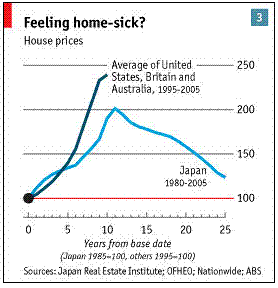
The accompanying image depicts house prices post the Housing Bubble. By 2004, the Japanese housing bubble had become completely obliterated. More than $20 trillion (1999 dollars) were wiped off with the combined collapse of the real estate market and the Tokyo stock market.
A class-A property in Tokyo’s financial districts were less than 1/100th of their peak, and Tokyo’s residential homes were 1/10th of their peak, and even at this time they were considered to be listed as the most expensive real estate in the world.
One of the main reasons for the failure in containing the housing bubble was the late intervention of the Japanese central bank, the Bank of Japan, which stepped in late-1989, when it was too late and rates were stratospheric.
As with any desperate moves, the action it took was far too heavy and too fast, raising benchmark interest rates from 2.5% to 6% over 15 months. This was too much for Japan's over-inflated land and stock markets to handle, and economists say that this pulled the rug out from under both markets at the same time.
The Japanese housing bubble was a result of the availability of cheap money, at low interest rates, while the US sub-prime crisis was a result of inflation driving up the interest rates, which forced the Fed to cut benchmark interest rates from 5.5% to 2.5%.
Primarily, it is the availability of excessive funds sloshing around in the economy that causes bubbles. In Japan, business corporations themselves indulged in real estate speculation, so when markets collapsed, it wiped out company balance sheets, crippled the nation’s banks, and gave the overall economy a blow to the chin. This appears to be very similar to what is currently happening in India.
Read the first story in this series: Why is India's Housing Bubble Similar to Japan's
This article has been developed from the October 2005 issues of the New York Times. You can read it here
![[Most Recent Quotes from www.kitco.com]](http://www.kitconet.com/charts/metals/gold/t24_au_en_ingr_2.gif)
![[Most Recent Exchange Rate from www.kitco.com]](http://www.weblinks247.com/exrate/24hr-inr-small.gif)








